Pizza di Scarola (Italian Christmas Eve Pizza)
1 recipe of pizza dough (see below)
25 -30 Gaeta olives pitted and coarsely chopped (Kalamata olives may also be used if Gaeta olives are not available)
4 T. pignoli (pine nuts)
4 tsp. organic black raisins, coarsely chopped
2 T. capers, coarsely chopped
1 head organic escarole, well washed
extra virgin olive oil, as needed to drizzle over pizza
sea salt, to taste
black pepper, to taste
Place olives, pine nuts, raisins and capers in a small or medium size bowl. Mix together and set aside.
Cut escarole in 8 parts lengthwise. Put it in a saucepan with
about 1 cup water, salt and black pepper and boil 5 minutes or until
very tender. Spread on plate to cool. Reserve the cooking water (it may be enjoyed as a beverage by adding a
little olive oil and seasoned with additional salt and pepper to taste
or used later in a soup broth -- store covered in the refrigerator
until ready to use).
Prepare the dough (see below). After it has risen, and has been pressed onto a prepared pizza
baking pan, spread the olive and raisin mixture over the surface,
then drizzle lightly with olive oil. Spread the escarole over the
pizza surface, and sprinkle with sea salt and black pepper.
Drizzle with olive oil.
Preheat oven thoroughly at 450 degrees; reduce to 425 degrees, and bake
pizza for about 20 -22 minutes. Crust should be
golden and crisp. Serve pizza hot. Place on a rack so the
bottom of the pizza does not become soggy.
This recipe originates from the Campania region of Italy and has
found its way to Pennsylvania, USA to become a holiday tradition
in my family. When I first made this pizza a number of
years ago, I was planning to serve it at a Christmas Eve dinner with
some of my in-laws. My husband was concerned that it might be
“too different.” --- After all it mixes raisins, olives and
capers. I trusted it would be delicious and it truly was!
Everybody loved it and nobody asked, “where’s the
cheese?” This is a wonderful and well-loved pizza that we
often make whenever escarole is available.
Coarsely ground walnuts (4 T.) may be substituted for pignoli without
changing the essence of the pizza. Serves 6 - 8. Buon
Natale!
Pizza Dough
3 cup organic flour (2 ½ cup unbleached white + 1/2 cup whole wheat)
1 & 1/4 tsp. sea salt
1 envelope yeast (2 ¼ tsp yeast)
1/3 cup soy milk (plain flavor), warm, not over 105° F
1 cup water, room temperature
3 T extra virgin olive oil
Place flour and salt in the bowl of a large size food processor. Pulse to mix flour and salt.
Meanwhile sprinkle yeast over the warm soymilk. Set aside for 5
minutes until foamy. Whisk in olive oil. Add yeast mixture
to flour while food processor is running. Add water a little at a
time with motor running. Add just enough so that a ball forms.
Remove dough and place in a large oiled bowl. Cover tightly with
plastic and a kitchen towel. Allow to rise in a warm place
without drafts until doubled-- about 1 & 1/2 - 2 hours. Punch
dough down. It is now ready to be pressed onto an oiled pizza
baking pan. Bake in preheated oven according to pizza recipe.
(See above).
Pizza dough certainly may be made by hand-kneading the
ingredients. I have offered this recipe that helps save some time
for the busy cook/baker. I have found kneading dough to be
relaxing and meditative; yet due to family and personal demands, I have
learned to use the food processor to keep my love of cooking and baking
manageable.
Insalata di Finocchio ed Arancie (Fennel & Orange Holiday Salad)
Serves Four
2 large fennel bulbs, trimmed and cored
3 seedless oranges (use Sicilian blood oranges if available)
1 small red onion
4 T extra- virgin olive oil
1 T red wine vinegar
sea salt, to taste (about 1/4 - 1/2 tsp)
freshly ground black pepper, to taste
Trim the tops and root ends from the fennel, and remove the small core
from the base of the bulbs. Remove the outer leaves if they are
tough or stringy. Rinse the bulbs and cut them in half
lengthwise. Place the fennel cut side down and cut crosswise into
medium slices.
Juice one orange, then set aside the juice for the dressing. Peel the 2
remaining oranges. Slice the oranges crosswise, then quarter the
slices. Set aside.
Peel and halve the red onion. Thinly slice and set aside.
In a small bowl, whisk together 2 T orange juice, the vinegar and
olive oil. Scatter the fennel, onion, and orange in a medium-size
salad bowl. Toss lightly with the dressing and season to taste
with salt and pepper.
This is a delicious and festive salad.
Oranges may easily be cut by using a serrated knife. This helps prevent
the loss of the luscious juice. For the best possible flavor, try
to use organic fennel, oranges and onion.
Holiday Vegan Nog
Serves 6-8
1 quart soy milk, vanilla flavor
6 oz. silken tofu, firm
3 T. evaporated cane juice (organic sugar)
2 tsp. vanilla extract
1 & 1/2 tsp. cinnamon
1/4 tsp. cardamom
1/4 tsp. nutmeg
1/4 tsp. ground cloves
In a blender, combine all ingredients and blend until smooth. Chill
well before serving. Store in a tightly closed glass container.
Shake well before serving.
This is a rich and delicious nog that has become part of our family holiday tradition. Enjoy!
Torta di Noci (Walnut Cake)
One 9 inch cake--Serves about 6
½ cup vegan butter substitute such as Earth Balance (plus more to prepare the baking pan)
2/3 cup evaporated cane juice (organic sugar
1 T. water
2 T. vanilla extract
zest of one lemon (use organic lemon)
1 & 1/2 tsp. baking powder
1/2 tsp. baking soda
2 ¼ cups finely ground walnuts (resembling meal)
1 cup all purpose flour (plus more for dusting the baking pan)
Preheat oven 350° F.
Prepare cake pan by coating with Earth Balance and dusting with flour.
Set aside. Cream Earth Balance and organic sugar with electric
mixer; when smooth and soft add water, zest of organic lemon, vanilla, baking powder and baking soda. Mix well.
Add the walnuts, a little at a time. When all the walnuts are
incorporated, add the flour a bit at a time, from a sifter or
sieve. The batter should be rather dense. Pour batter into
pan, spread evenly. Bake in top part of oven about 40
-45 minutes.--until firm to touch. Make sure it does not become overly
brown; the cake should be golden. Remove from oven, and
remove from pan to cool on a rack.
Torta di noci is actually better the next day. Keep cool and wrap
in plastic. But do NOT store in the refrigerator. Before serving
sprinkle with organic confectioner’s sugar.
This cake is served during Christmas time in Calabria, Italy. I
love the dense walnut cake. Veganizing the Italian recipe was not
at all difficult. I hope to further develop this recipe so that
it may be enjoyed by F/friends who eat a gluten free diet. I
would probably experiment with brown rice flour.
The hint of lemon flavor combined with the walnuts and vanilla is warm
and delicious. This cake makes a delightful dessert or mid-day treat
served with coffee. May we all find time to savor occasions
shared with F/friends throughout the year.
Vegan Sour Cream
Yields 1 ¼ cups
12 oz silken tofu, firm (1 aseptic package)
3 T. mild vegetable oil (such as safflower)
1 tsp. evaporated cane juice (organic sugar)
juice of 1 lemon
½ tsp salt
Blend in blender on high speed until very smooth. Store covered in a glass container. Use as sour cream.
Onion-Dill Dip Variation
1 recipe of Vegan Sour Cream
2 tsp. apple cider vinegar
1 tsp. Tamari
1/2 - 1 tsp. organic sugar
1/2 tsp. granulated onion (a slightly coarser grind than onion powder)
1/2 tsp. dried dill
Place all ingredients in a blender. Blend on high speed until
very smooth. Store in a tightly closed glass container.
Allow flavors to blend at least an hour before serving.
This dip will be welcomed at holiday parties and nicely accompanies vegetables and/or chips.
I once served Vegan Sour Cream to a non-vegetarian Friend, who thought
it was odd to use tofu in a manner that is was not supposed to be
used. The Friend however did find the vegan sour cream to be
quite palatable; but could not make the connection between our food and
our choices to act with compassion. Personally, I do not think
that cows are supposed to be forced into pregnancy so that human can
use the milk that was meant to nourish their calves. Because of
our thoughtless cravings, most calves never have the opportunity
to taste their own mothers' milk, or to experience the nurturance they long for.
Please enjoy this compassionate alternative to dairy throughout the year and the upcoming new year. Peace to all!
—Angela Suarez

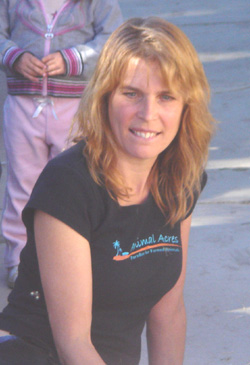 Several recent visits to a new farmed-animal shelter in Southern
California, Animal Acres, founded by Lorri Bauston (pictured at right), has brought this comparison vividly to my
mind. I do not claim that the people who run it are
necessarily conscious of the connection themselves, but all works of
compassion may be said to have the same divine Source, and to my mind, these
folk have offered themselves to be the hands of God on earth.
Several recent visits to a new farmed-animal shelter in Southern
California, Animal Acres, founded by Lorri Bauston (pictured at right), has brought this comparison vividly to my
mind. I do not claim that the people who run it are
necessarily conscious of the connection themselves, but all works of
compassion may be said to have the same divine Source, and to my mind, these
folk have offered themselves to be the hands of God on earth.
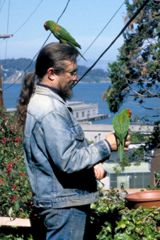 This
exceptional movie is a must for animal lovers. Set in San
Francisco amid the glorious vistas of the City on the Bay, it depicts
the remarkable relationship of a man worthy of the city’s
namesake with a flock of parrots. Mark Bittner, looking
like a middle-aged hippie, and like the saint from Assisi a homeless
troubadour with a heart for birds, first met the squawking, colorful
visitors while house-sitting on Telegraph Hill. He
recognized in the parrots an impressive similarity to his own situation
of being at home in exile: the birds, mostly cherry-headed conures who
had presumably escaped from human “owners,” were far from
their native South American terrain and dependent on the universe, or
friends, for their day-to-day sustenance.
This
exceptional movie is a must for animal lovers. Set in San
Francisco amid the glorious vistas of the City on the Bay, it depicts
the remarkable relationship of a man worthy of the city’s
namesake with a flock of parrots. Mark Bittner, looking
like a middle-aged hippie, and like the saint from Assisi a homeless
troubadour with a heart for birds, first met the squawking, colorful
visitors while house-sitting on Telegraph Hill. He
recognized in the parrots an impressive similarity to his own situation
of being at home in exile: the birds, mostly cherry-headed conures who
had presumably escaped from human “owners,” were far from
their native South American terrain and dependent on the universe, or
friends, for their day-to-day sustenance. 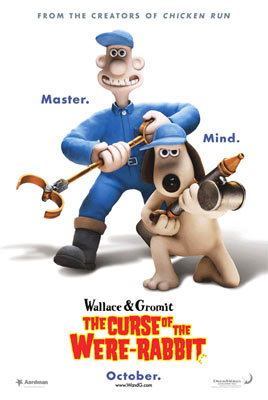 In Totting Town, a small village in England, everybody (well--almost
In Totting Town, a small village in England, everybody (well--almost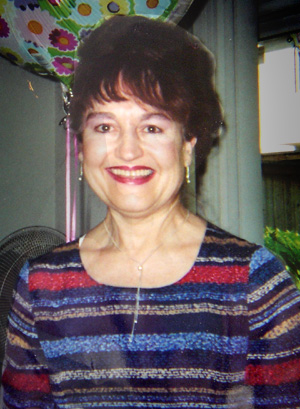 From the time I can remember, I felt extremely close to animals.
I never enjoyed eating meat, but did not understand why. From
childhood through early adulthood, several pivotal and traumatic
situations occurred in my life that marked my decision not to eat
animal flesh. The first event occurred when I was seven years
old, one day when my mother had just served breakfast. I asked my father
what we were eating, and he said that we were eating a cow. I was
horrified. It was incomprehensible to me how an innocent animal
could be killed, cut up, and sold for food. I told my father I no
longer wanted to eat meat, but he said I had to. He then
proceeded to explain the importance of eating meat. Something
told me this was inhumane. I knew that when I was old enough to
make my own decisions, I would choose otherwise.
From the time I can remember, I felt extremely close to animals.
I never enjoyed eating meat, but did not understand why. From
childhood through early adulthood, several pivotal and traumatic
situations occurred in my life that marked my decision not to eat
animal flesh. The first event occurred when I was seven years
old, one day when my mother had just served breakfast. I asked my father
what we were eating, and he said that we were eating a cow. I was
horrified. It was incomprehensible to me how an innocent animal
could be killed, cut up, and sold for food. I told my father I no
longer wanted to eat meat, but he said I had to. He then
proceeded to explain the importance of eating meat. Something
told me this was inhumane. I knew that when I was old enough to
make my own decisions, I would choose otherwise.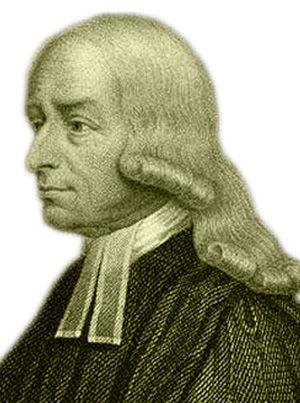 John
Wesley (1703-1791), leader of the renewal movement in the Church of
England that became the Methodist denomination, was a vegetarian who
was distressed about the suffering of animals. The connection
between his diet and his concern would seem obvious, but just what the
connection was we cannot be sure. One modern critic, Colin
Spencer (in
John
Wesley (1703-1791), leader of the renewal movement in the Church of
England that became the Methodist denomination, was a vegetarian who
was distressed about the suffering of animals. The connection
between his diet and his concern would seem obvious, but just what the
connection was we cannot be sure. One modern critic, Colin
Spencer (in  At once a voice arose among
At once a voice arose among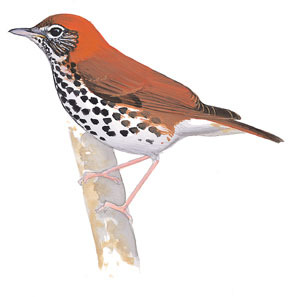 The labyrinthine heart,
The labyrinthine heart,